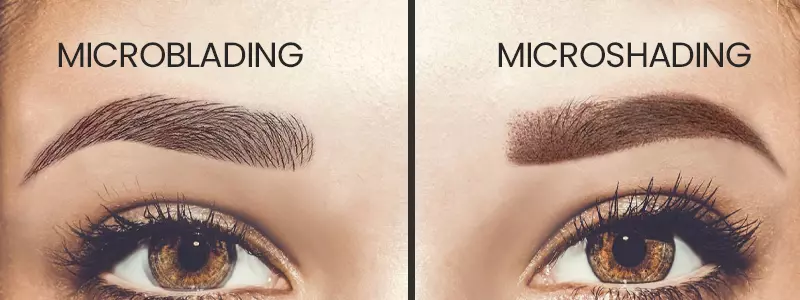Microblading and microshading are semi-permanent makeup techniques designed to enhance the appearance of eyebrows, making them appear fuller and more defined. These treatments tend to be the long-term alternatives to daily eyebrow makeup, which can be intimidating at times. Both use medical-grade tattoo ink to fill the visible gaps within the eyebrows. Due to their resembling procedures and almost identical pre-treatment and aftercare instructions, many think of them as the same treatment.
While microblading and microshading have some traits in common and can be regarded as sister treatments, they are not the same. Both use different techniques and offer unique results. In this blog, we will discuss these differences and explore which option is right for you. But first, let’s talk about what both these treatments involve.
What is Microblading?
Microblading is a semi-permanent tattooing technique in which pigments are inserted into the skin of the brow area. It involves using a hand-held tool equipped with a microblade to create hair-like strokes that are then filled with pigment. This gives an impression of natural brow hairs.
What is Microshading?
Similar to microblading, Microshading or powdered brows is a semi-permanent eyebrow tattooing technique. But unlike microblading, it does not create hair strokes. Instead, it creates tiny dots that bring a powdered, shadowy effect. This treatment aims to make otherwise sparse eyebrows look fuller and thicker.
What is the Difference Between Microshading and Microblading?
The most significant difference between both these procedures lies in their precise technique and the outcome they offer. Microblading creates hair-like strokes to fill gaps in the eyebrows, whereas microshading renders dots or pixels to give the brows a shaded, denser appearance.
Other differences between microblading and microshading are as follows:
What are the Goals of Microblading and Microshading?
- Microblading aims to mimic the appearance of natural eyebrow hairs, enhancing the brow’s overall volume and shape with a feathered effect.
- Microshading is designed to provide a soft, powdery backdrop that adds depth and definition to the eyebrows, creating a more defined, denser brow arch.
Difference Between Microblading And Microshading Procedures
Microblading is a manual procedure that uses a pen-shaped tool with a tiny blade at the end. This blade pierces the topmost layer of the brow skin to create strokes that simulate the appearance of natural brow hairs. The blade’s edge is lined with fine needles that dispense small quantities of pigment into each stroke, crafting the illusion of natural brow hairs.
Similarly, micro shading uses a tool similar to that used in microblading. However, it employs a different technique to create a soft, powdery fill instead of hair-like strokes. The fine needle at the end of this tool makes tiny punctures in the brow area, which are simultaneously filled with pigment. The aim is to create a shaded, powdered look of the eyebrows without the sharp edges of individual hair strokes.
How long do microblading and microshading last?
Microblading typically lasts between 18 and 30 months; finer strokes may begin to fade sooner.
On the other hand, microshading can last from 2 to 3 years, depending on skin type and care, potentially outlasting the effects of microblading.
Microshading versus Microblading: Pros And Cons
Microblading
The microblading procedure has the following pros and cons.
Pros
- Creates realistic hair-like strokes.
- Ideal for individuals with dry skin types.
- It offers a lighter finish.
Cons
- Results are semi-permanent; touch-up sessions may be required as the effect fades over time.
- You may experience mild to moderate pain or discomfort.
- Cosmetic procedures like microblading and microshading are generally not covered by medical insurance.
Microshading
Microshading has the following pros and cons.
Pros
- Microshading provides a soft, powdered effect that mimics the look of eyebrow makeup.
- The eyebrows look thicker and fuller.
- Suitable for individuals with oily skin; those with sensitive skin should consult a specialist due to potential irritation.
Cons
- Like microblading, microshading offers semi-permanent results that require maintenance touch-ups for longevity.
- The treatment is not covered by insurance.
- You will feel mild pain and discomfort.
Which is Better, Microshading or Microblading?
The choice between these procedures largely depends on the skin type and your desired outcome. Other factors include your lifestyle and maintenance preferences. Generally speaking, microshading suits oily and sensitive skin better, while microblading is considered ideal for dry skin.
In the end, it is crucial to select a licensed and experienced practitioner whether you are going for microblading or microshading. This will help you ensure safety, minimize risks, and achieve the best possible results. A qualified practitioner will also thoroughly analyze your skin type, aesthetic requirements, and preferences to help you choose the better option.




